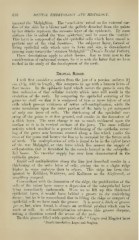Page 606 - My FlipBook
P. 606
616 DENTAL EMBRYOLOGY AND HISTOLOGY.
internal the INIalpighian. The ' scarf-skin ' raised on tlie external sur-
face of the skin by a l)lister and the pellicle detached from the palate
bv hot drinks represent the corneous layer of the epidermis. By some
authors this is called the ' true epidermis/ and by some the ' cuticle,'
This layer is composed of the old epithelial cells which have ceased to
perform any of the vital functions. The subjacent layer, formed of
living epithelial cells which vary in form and size, is denominated
(among: many terms) the ' stratum Malpighii ' " (Dean's Dental FoUicle).
These descriptions apply to adult tissues. Let us turn uom^ to the
consideration of embryonal tissues, for it is with the latter that we have
to deal in the study of the development of the teeth.
Dental Ridge.
I will first consider a section from the jaw of a porcine embryo 1^
cm. (Fig. 341 ) in length ; this compares in age with a human fcetus of
four weeks. In the epiblastic layer which covers the gums is seen the
first indication of that cellular activity which later will result in the
evolution of the teeth. By comparing the epithelial covering of the
gums we shall see that it is composed of two or more layers of oval
cells which present evidences of active cell-multiplication, while the
same membrane upon the outer portion of the body is yet composed
of only one layer of cells. The thickening of the epithelial cov-
ering of the gums is at first general, and results in the formation of
a thick layer. The next change is not so much evidenced upon the
surface as it is in vertical sections of the jaws. The same cellular
activity which resulted in a general thickening of the epithelial cover-
ing of the gums now becomes centred along a line which marks the
crest of the gums and locates the line to be occupied by the future arch
of teeth. The multiplication of cells is found to be in the infant layer
of the rete jSIalpighii, or that layer which lies nearest the supply of
cell-jiabulum that is furnished by the vessels located in the subepithe-
lial tissue. No vascular supply has ever been demonstrated in the
cpithelia pro])er.
Rapid cell-nudtiplication along the line just described results in a
thickening of the o/der layer of cells, giving rise to a slight ridge
higher in some embryos than in others. This ridge has been des-
ignated by K()lliker, Waldeyer, and Kallman as the Kieferwall, or
maxillary rampart.
Concomitant with the formation of the ridge, the proliferation of the
cells of the infant layer causes a depression of the subejMthelial layer
lying inmiediately underneath. Were we to lift up this thickened
e])ith('lial layer, it would leave behind a groove in the underlying
tissue ; but let it be remembered that in lifting the ridge or rampart of
e])ithelial cells we have made the groove. It is never a ditch or groove
per se, but, when found, is always an artificial product which can be
made at Avill. As cell-nmltiplication advances this groove deepens,
taking a direction toward the centre of the arch.
To this groove filled with epithelial cells' " Legro and Magitot have
' Dean's translation, Legro and Magitot.


